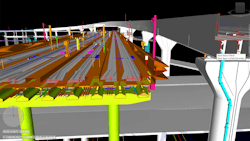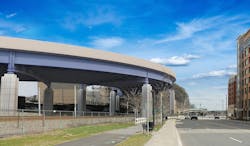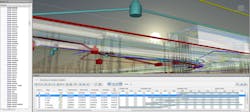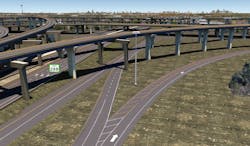Four reasons why 3D modeling and BIM are the future of infrastructure design
Twenty years into the 21st Century we’re still using outdated design technology for critical infrastructure projects. Building information modeling (BIM)—basically 3D engineered models—is widely adopted in the buildings industry. If you don’t design with BIM for a building, you are old school—and not in a good way.
BIM is a mature design methodology that shows potential for improving the way we deliver transportation projects. But still, the transportation industry is lagging.
The need for BIM is clear. Transportation structures are aging—in some cases, they are significantly past their “expiration date.” And the population, especially in urban areas, continues to grow and put more strain on the old infrastructure. This combination of challenges means that now is the time for more efficient and cost-effective technologies to build, maintain, monitor and repair roads, bridges and other infrastructure.
Exit the old fashioned 2D paper-only set of plans and their limitations. Enter 3D digital models—and even 4D and 5D—with much more detail, fewer errors, increased safety and significant savings. Digital models offer four significant improvements over the existing industry standard.
1. Better cost predictability—and a look at 4D and 5D
The industry has been designing roads, bridges and other projects for decades using 2D plan sets. It works. Look around, there are lots of roads and bridges. But it doesn’t work as well as it could. Look at those projects again. How often is there a disconnect between what’s on paper and what gets built? When cutting a cross section every 50 feet, there is a lot of room for misinterpretation. Honestly, it’s a bit of a guessing game between the designer and the contractor. And the client sometimes loses. With digital modeling, you know exactly what to expect.
And when the 4D (schedule) and 5D (cost) elements of the digital model are added, it becomes even more valuable.
Naturally, scheduling and budgeting are two major factors in the success of projects, especially mega projects like two I recently worked on—the Red and Purple Line Modernization Program in Chicago and the Long Island Rail Road Expansion project in New York.
The 4D aspect of a digital model allows construction scheduling to be an integral part of the plan. seethe plans show where everything is going to be built—in some cases, right down to installation of signs or striping of the roads.
For 5D, costs are integrated into the project. The client and contractor will know when materials are due to arrive on site, when they will need to pay for the materials and when the invoices will come. This helps eliminate cost overruns.
2. Fewer errors—3D models make it easy to spot mistakes
There are few things more heartbreaking on a project than having concrete poured, only to tear it back up because of an error. Digital models greatly reduce errors, ultimately saving time and money. When mistakes are corrected in the field, they can be exponentially more expensive than if they had been fixed in the design phase.
With a 3D model, designers immediately see if something looks wrong. The digital models naturally provide clash detection because they show the full project. If pipes intersect one another or hit a bridge footing, it’s immediately visible in 3D. 2D plans simply don’t show the conflicts. And traditional plan sets usually include cross sections every 50 or 100 feet. That requires the contractor to interpret the plans in between the cross sections. A 3D model is basically one giant cross section, providing a level of detail impossible in the 2D world.
3. Better understanding—and happier stakeholders
Wouldn’t it be great to walk through a project before a single cubic foot of concrete has been poured? Of course. And that’s what a digital model provides.
It’s a game-changer for public involvement. The public often has a difficult time visualizing project concepts by looking at engineering drawings. But models can be presented at a public meeting and show exactly what the project will look like when finished. The client doesn’t want surprises at the end of the project, and the community certainly doesn’t want an eyesore. Models help show what it will look like. How amazing it is to have someone virtually stand in their own driveway and look up and down the finished road. They don’t have to guess what it will look like—they can see it for themselves.
During the COVID-19 pandemic, Stantec used an Oculus Quest headset and had five people stand inside the model simultaneously on one of the project sites. That sort of visualization leads to better and more comprehensive design. As a design team, we were able to fix a variety of issues before construction started.
And it’s great for the client because they don’t have to guess how it’s going to look. And the contractor can’t say they didn’t understand. They’ve seen the full project before ever starting construction.
4. Lower cost, better product and safer construction
3D model designs cost more to create than traditional designs. Maybe up to 10 percent more in the design fee. And that sounds like a lot, until you realize the expected savings on the construction bottom line is about four percent.
That percent on a $2-billion project is $80 million. The design might cost 10 percent more, but the savings in construction is so significant that the higher design costs are essentially drops in the bucket. By having a complete 3D model, there are fewer change orders. Fewer change orders mean major savings—both in dollars and in time.
Precision comes from automating many functions, including placing subgrade, base course, pavement and using steamrollers. The more human elements that can be removed from the process, the less room there is for error. Surveyors are humans, too. Sometimes mistakes mean we grade the road incorrectly—then we must fix it. Automation, which comes from the 3D model, is better.
The future is 3D
In today’s tech-heavy world, the traditional paper-only plan sets are a throwback to an older world. , It’s time for advancement. With BIM/3D modeling for infrastructure projects, we can provide clients, contractors and the project neighbors a better highway, road, bridge or other infrastructure, and for less cost.
It’s exciting to see where modeling will take the industry. With 3D models, we set ourselves up for future improvements, such as embedding sensors in a bridge to track how it’s performing, creating digital as-builts, monitoring for CO2 levels—the options are almost endless.
3D digital models give us much more detail, fewer errors, significant savings and a safer worksite. It’s time for the digital future to become today’s reality.
------------------------
About the Author
John Barone
Senior Associate, Digital Practice Manager
John Barone oversees a team supporting all of Stantec's digital design platforms. This includes leveraging new technologies like parametric, computational and generative design to help better deliver work, faster. His team also uses animation, visualization and virtual and augmented reality.
Supporting every sector and discipline in which Stantec operates, John loves solving problems—how do we create a better design, provide more value to clients, or use a new technology to win or better deliver a project? Currently, John’s team is working towards moving our Infrastructure team to 3D model-based design. This is a huge undertaking that will include training for leadership, project managers and practitioners.





